Coursework: TQM and Balance Scorecard Relationship Analysis
VerifiedAdded on 2022/11/25
|9
|2912
|396
Essay
AI Summary
This coursework critically analyzes the relationship between Total Quality Management (TQM) and the Balanced Scorecard, arguing that TQM, a management approach focused on continuous quality improvement and customer satisfaction, is intrinsically linked to the Balanced Scorecard, a strategic performance management tool. The essay explores how TQM practices, aimed at enhancing efficiency and eliminating waste, align with the Balanced Scorecard's perspectives—financial, customer, internal processes, and learning and growth—to drive organizational success. It highlights that while TQM emphasizes process-centered improvements and data-driven decision-making, the Balanced Scorecard provides a broader framework for translating strategy into measurable objectives and initiatives, ensuring a holistic view of organizational performance. The analysis further discusses how the Balanced Scorecard addresses some limitations of TQM by incorporating employee satisfaction as a key element, leading to improved overall performance and strategic alignment, while also acknowledging potential drawbacks of the BSC, such as its limited perspective and subjective nature. This relationship demonstrates how companies can achieve their quality objectives and meet stakeholder expectations by fulfilling all perspectives.
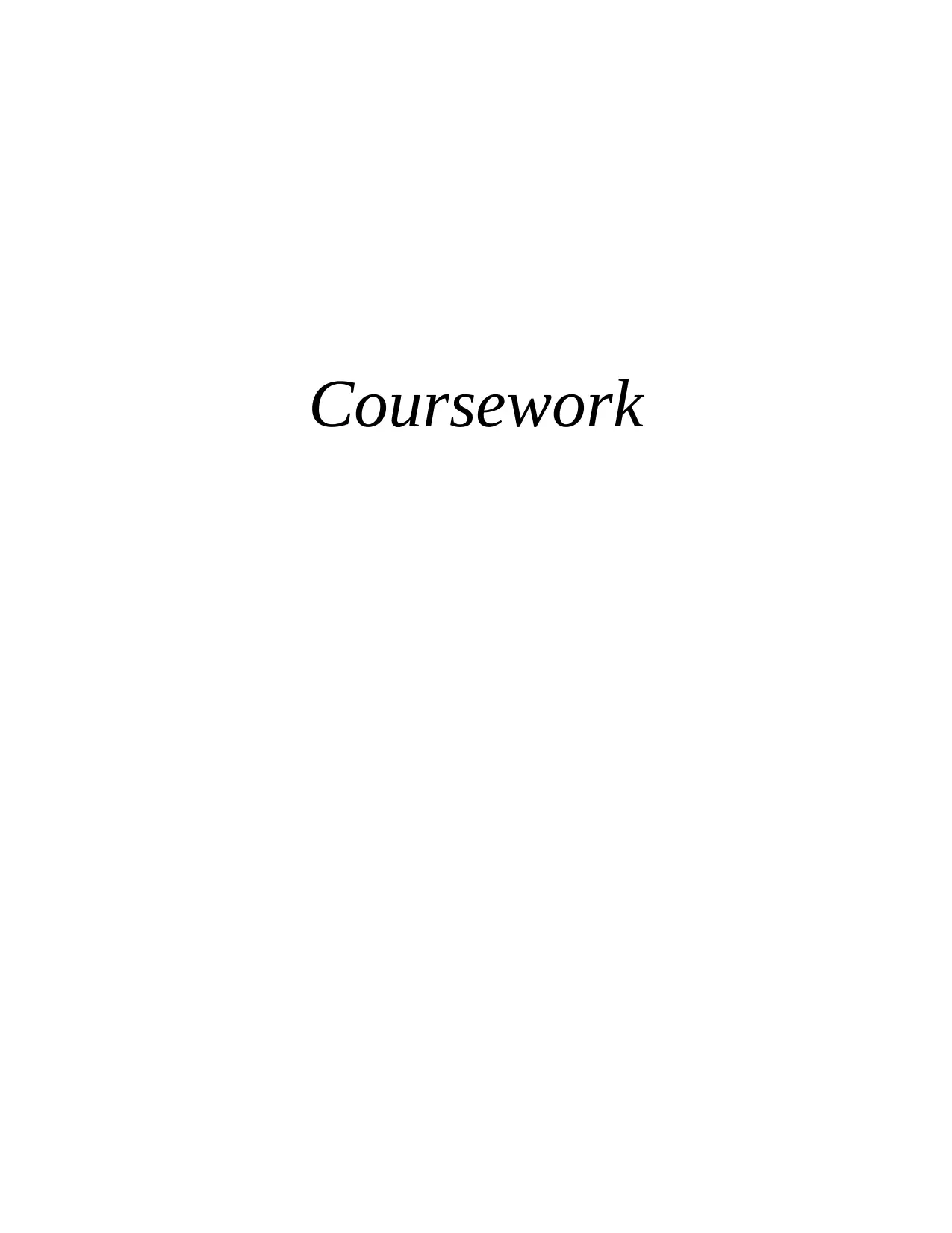
Coursework
Paraphrase This Document
Need a fresh take? Get an instant paraphrase of this document with our AI Paraphraser
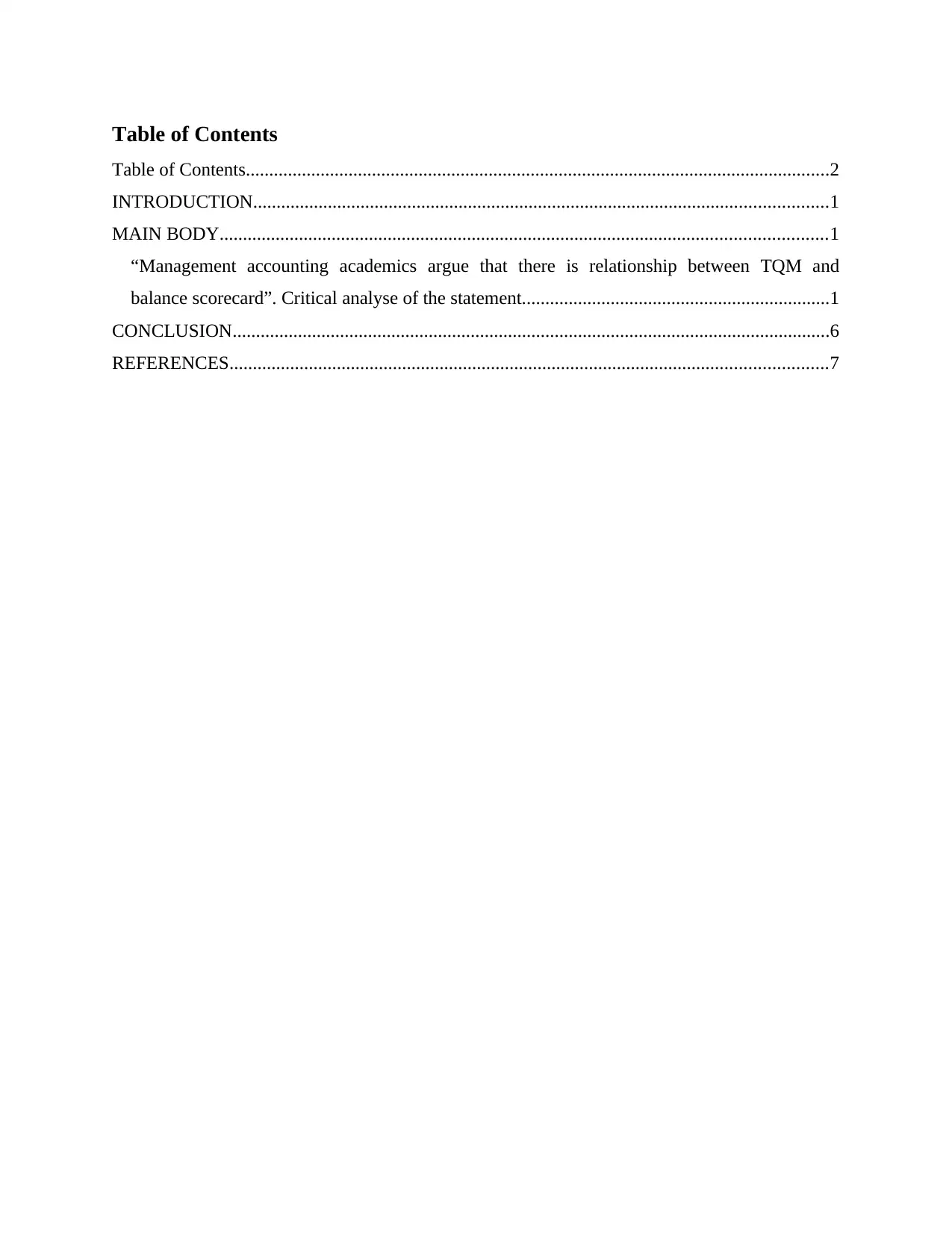
Table of Contents
Table of Contents.............................................................................................................................2
INTRODUCTION...........................................................................................................................1
MAIN BODY..................................................................................................................................1
“Management accounting academics argue that there is relationship between TQM and
balance scorecard”. Critical analyse of the statement..................................................................1
CONCLUSION................................................................................................................................6
REFERENCES................................................................................................................................7
Table of Contents.............................................................................................................................2
INTRODUCTION...........................................................................................................................1
MAIN BODY..................................................................................................................................1
“Management accounting academics argue that there is relationship between TQM and
balance scorecard”. Critical analyse of the statement..................................................................1
CONCLUSION................................................................................................................................6
REFERENCES................................................................................................................................7
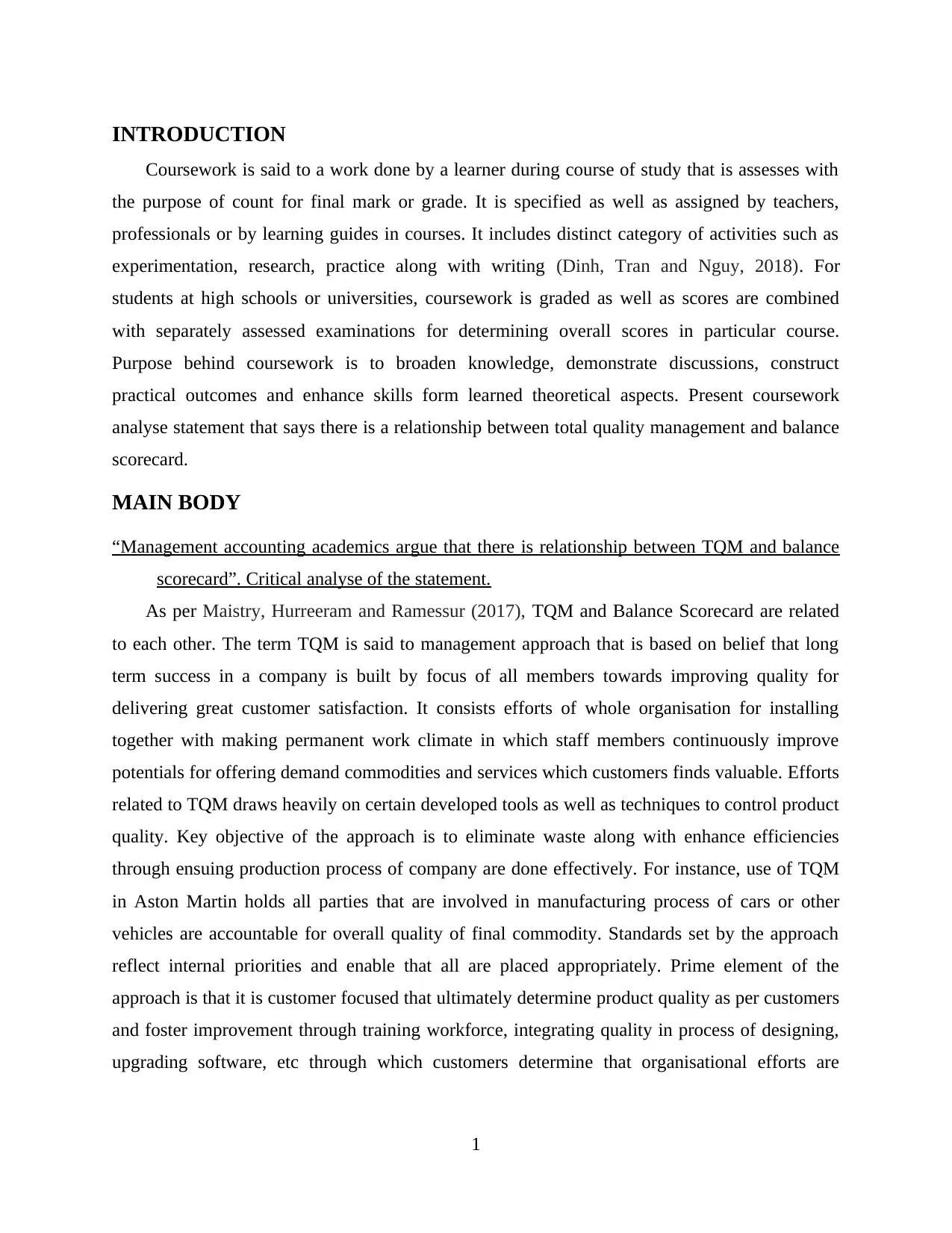
INTRODUCTION
Coursework is said to a work done by a learner during course of study that is assesses with
the purpose of count for final mark or grade. It is specified as well as assigned by teachers,
professionals or by learning guides in courses. It includes distinct category of activities such as
experimentation, research, practice along with writing (Dinh, Tran and Nguy, 2018). For
students at high schools or universities, coursework is graded as well as scores are combined
with separately assessed examinations for determining overall scores in particular course.
Purpose behind coursework is to broaden knowledge, demonstrate discussions, construct
practical outcomes and enhance skills form learned theoretical aspects. Present coursework
analyse statement that says there is a relationship between total quality management and balance
scorecard.
MAIN BODY
“Management accounting academics argue that there is relationship between TQM and balance
scorecard”. Critical analyse of the statement.
As per Maistry, Hurreeram and Ramessur (2017), TQM and Balance Scorecard are related
to each other. The term TQM is said to management approach that is based on belief that long
term success in a company is built by focus of all members towards improving quality for
delivering great customer satisfaction. It consists efforts of whole organisation for installing
together with making permanent work climate in which staff members continuously improve
potentials for offering demand commodities and services which customers finds valuable. Efforts
related to TQM draws heavily on certain developed tools as well as techniques to control product
quality. Key objective of the approach is to eliminate waste along with enhance efficiencies
through ensuing production process of company are done effectively. For instance, use of TQM
in Aston Martin holds all parties that are involved in manufacturing process of cars or other
vehicles are accountable for overall quality of final commodity. Standards set by the approach
reflect internal priorities and enable that all are placed appropriately. Prime element of the
approach is that it is customer focused that ultimately determine product quality as per customers
and foster improvement through training workforce, integrating quality in process of designing,
upgrading software, etc through which customers determine that organisational efforts are
1
Coursework is said to a work done by a learner during course of study that is assesses with
the purpose of count for final mark or grade. It is specified as well as assigned by teachers,
professionals or by learning guides in courses. It includes distinct category of activities such as
experimentation, research, practice along with writing (Dinh, Tran and Nguy, 2018). For
students at high schools or universities, coursework is graded as well as scores are combined
with separately assessed examinations for determining overall scores in particular course.
Purpose behind coursework is to broaden knowledge, demonstrate discussions, construct
practical outcomes and enhance skills form learned theoretical aspects. Present coursework
analyse statement that says there is a relationship between total quality management and balance
scorecard.
MAIN BODY
“Management accounting academics argue that there is relationship between TQM and balance
scorecard”. Critical analyse of the statement.
As per Maistry, Hurreeram and Ramessur (2017), TQM and Balance Scorecard are related
to each other. The term TQM is said to management approach that is based on belief that long
term success in a company is built by focus of all members towards improving quality for
delivering great customer satisfaction. It consists efforts of whole organisation for installing
together with making permanent work climate in which staff members continuously improve
potentials for offering demand commodities and services which customers finds valuable. Efforts
related to TQM draws heavily on certain developed tools as well as techniques to control product
quality. Key objective of the approach is to eliminate waste along with enhance efficiencies
through ensuing production process of company are done effectively. For instance, use of TQM
in Aston Martin holds all parties that are involved in manufacturing process of cars or other
vehicles are accountable for overall quality of final commodity. Standards set by the approach
reflect internal priorities and enable that all are placed appropriately. Prime element of the
approach is that it is customer focused that ultimately determine product quality as per customers
and foster improvement through training workforce, integrating quality in process of designing,
upgrading software, etc through which customers determine that organisational efforts are
1
⊘ This is a preview!⊘
Do you want full access?
Subscribe today to unlock all pages.

Trusted by 1+ million students worldwide
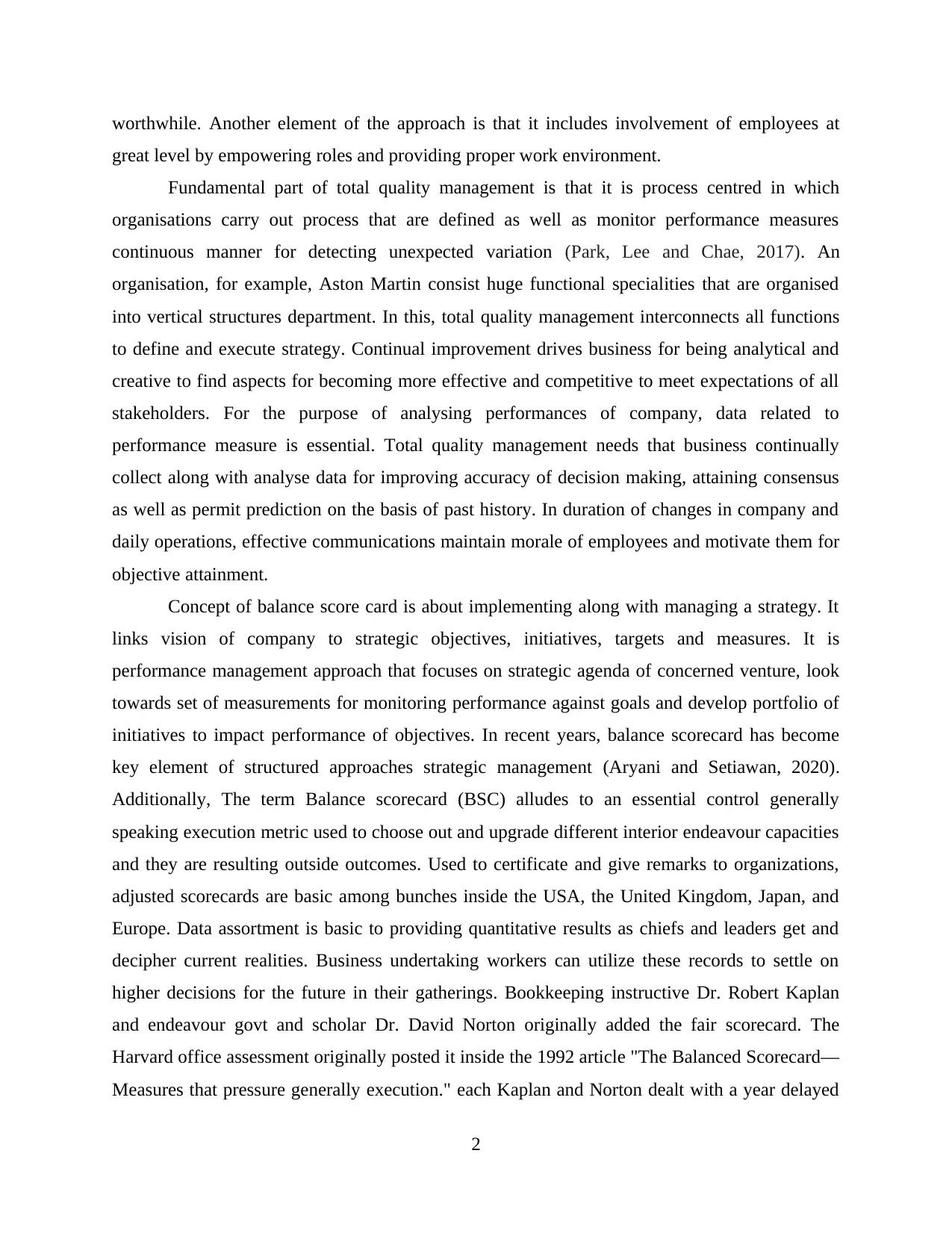
worthwhile. Another element of the approach is that it includes involvement of employees at
great level by empowering roles and providing proper work environment.
Fundamental part of total quality management is that it is process centred in which
organisations carry out process that are defined as well as monitor performance measures
continuous manner for detecting unexpected variation (Park, Lee and Chae, 2017). An
organisation, for example, Aston Martin consist huge functional specialities that are organised
into vertical structures department. In this, total quality management interconnects all functions
to define and execute strategy. Continual improvement drives business for being analytical and
creative to find aspects for becoming more effective and competitive to meet expectations of all
stakeholders. For the purpose of analysing performances of company, data related to
performance measure is essential. Total quality management needs that business continually
collect along with analyse data for improving accuracy of decision making, attaining consensus
as well as permit prediction on the basis of past history. In duration of changes in company and
daily operations, effective communications maintain morale of employees and motivate them for
objective attainment.
Concept of balance score card is about implementing along with managing a strategy. It
links vision of company to strategic objectives, initiatives, targets and measures. It is
performance management approach that focuses on strategic agenda of concerned venture, look
towards set of measurements for monitoring performance against goals and develop portfolio of
initiatives to impact performance of objectives. In recent years, balance scorecard has become
key element of structured approaches strategic management (Aryani and Setiawan, 2020).
Additionally, The term Balance scorecard (BSC) alludes to an essential control generally
speaking execution metric used to choose out and upgrade different interior endeavour capacities
and they are resulting outside outcomes. Used to certificate and give remarks to organizations,
adjusted scorecards are basic among bunches inside the USA, the United Kingdom, Japan, and
Europe. Data assortment is basic to providing quantitative results as chiefs and leaders get and
decipher current realities. Business undertaking workers can utilize these records to settle on
higher decisions for the future in their gatherings. Bookkeeping instructive Dr. Robert Kaplan
and endeavour govt and scholar Dr. David Norton originally added the fair scorecard. The
Harvard office assessment originally posted it inside the 1992 article "The Balanced Scorecard—
Measures that pressure generally execution." each Kaplan and Norton dealt with a year delayed
2
great level by empowering roles and providing proper work environment.
Fundamental part of total quality management is that it is process centred in which
organisations carry out process that are defined as well as monitor performance measures
continuous manner for detecting unexpected variation (Park, Lee and Chae, 2017). An
organisation, for example, Aston Martin consist huge functional specialities that are organised
into vertical structures department. In this, total quality management interconnects all functions
to define and execute strategy. Continual improvement drives business for being analytical and
creative to find aspects for becoming more effective and competitive to meet expectations of all
stakeholders. For the purpose of analysing performances of company, data related to
performance measure is essential. Total quality management needs that business continually
collect along with analyse data for improving accuracy of decision making, attaining consensus
as well as permit prediction on the basis of past history. In duration of changes in company and
daily operations, effective communications maintain morale of employees and motivate them for
objective attainment.
Concept of balance score card is about implementing along with managing a strategy. It
links vision of company to strategic objectives, initiatives, targets and measures. It is
performance management approach that focuses on strategic agenda of concerned venture, look
towards set of measurements for monitoring performance against goals and develop portfolio of
initiatives to impact performance of objectives. In recent years, balance scorecard has become
key element of structured approaches strategic management (Aryani and Setiawan, 2020).
Additionally, The term Balance scorecard (BSC) alludes to an essential control generally
speaking execution metric used to choose out and upgrade different interior endeavour capacities
and they are resulting outside outcomes. Used to certificate and give remarks to organizations,
adjusted scorecards are basic among bunches inside the USA, the United Kingdom, Japan, and
Europe. Data assortment is basic to providing quantitative results as chiefs and leaders get and
decipher current realities. Business undertaking workers can utilize these records to settle on
higher decisions for the future in their gatherings. Bookkeeping instructive Dr. Robert Kaplan
and endeavour govt and scholar Dr. David Norton originally added the fair scorecard. The
Harvard office assessment originally posted it inside the 1992 article "The Balanced Scorecard—
Measures that pressure generally execution." each Kaplan and Norton dealt with a year delayed
2
Paraphrase This Document
Need a fresh take? Get an instant paraphrase of this document with our AI Paraphraser
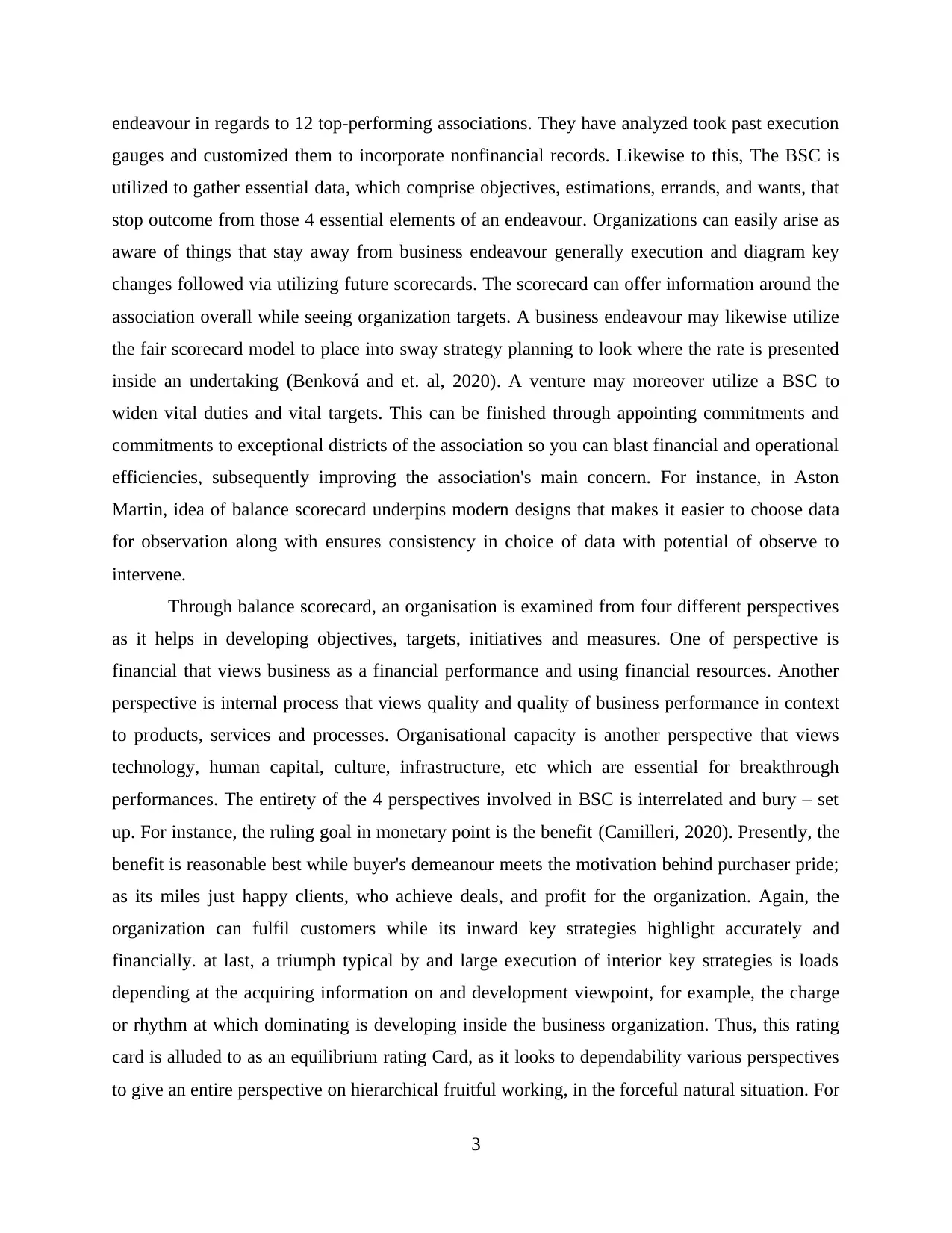
endeavour in regards to 12 top-performing associations. They have analyzed took past execution
gauges and customized them to incorporate nonfinancial records. Likewise to this, The BSC is
utilized to gather essential data, which comprise objectives, estimations, errands, and wants, that
stop outcome from those 4 essential elements of an endeavour. Organizations can easily arise as
aware of things that stay away from business endeavour generally execution and diagram key
changes followed via utilizing future scorecards. The scorecard can offer information around the
association overall while seeing organization targets. A business endeavour may likewise utilize
the fair scorecard model to place into sway strategy planning to look where the rate is presented
inside an undertaking (Benková and et. al, 2020). A venture may moreover utilize a BSC to
widen vital duties and vital targets. This can be finished through appointing commitments and
commitments to exceptional districts of the association so you can blast financial and operational
efficiencies, subsequently improving the association's main concern. For instance, in Aston
Martin, idea of balance scorecard underpins modern designs that makes it easier to choose data
for observation along with ensures consistency in choice of data with potential of observe to
intervene.
Through balance scorecard, an organisation is examined from four different perspectives
as it helps in developing objectives, targets, initiatives and measures. One of perspective is
financial that views business as a financial performance and using financial resources. Another
perspective is internal process that views quality and quality of business performance in context
to products, services and processes. Organisational capacity is another perspective that views
technology, human capital, culture, infrastructure, etc which are essential for breakthrough
performances. The entirety of the 4 perspectives involved in BSC is interrelated and bury – set
up. For instance, the ruling goal in monetary point is the benefit (Camilleri, 2020). Presently, the
benefit is reasonable best while buyer's demeanour meets the motivation behind purchaser pride;
as its miles just happy clients, who achieve deals, and profit for the organization. Again, the
organization can fulfil customers while its inward key strategies highlight accurately and
financially. at last, a triumph typical by and large execution of interior key strategies is loads
depending at the acquiring information on and development viewpoint, for example, the charge
or rhythm at which dominating is developing inside the business organization. Thus, this rating
card is alluded to as an equilibrium rating Card, as it looks to dependability various perspectives
to give an entire perspective on hierarchical fruitful working, in the forceful natural situation. For
3
gauges and customized them to incorporate nonfinancial records. Likewise to this, The BSC is
utilized to gather essential data, which comprise objectives, estimations, errands, and wants, that
stop outcome from those 4 essential elements of an endeavour. Organizations can easily arise as
aware of things that stay away from business endeavour generally execution and diagram key
changes followed via utilizing future scorecards. The scorecard can offer information around the
association overall while seeing organization targets. A business endeavour may likewise utilize
the fair scorecard model to place into sway strategy planning to look where the rate is presented
inside an undertaking (Benková and et. al, 2020). A venture may moreover utilize a BSC to
widen vital duties and vital targets. This can be finished through appointing commitments and
commitments to exceptional districts of the association so you can blast financial and operational
efficiencies, subsequently improving the association's main concern. For instance, in Aston
Martin, idea of balance scorecard underpins modern designs that makes it easier to choose data
for observation along with ensures consistency in choice of data with potential of observe to
intervene.
Through balance scorecard, an organisation is examined from four different perspectives
as it helps in developing objectives, targets, initiatives and measures. One of perspective is
financial that views business as a financial performance and using financial resources. Another
perspective is internal process that views quality and quality of business performance in context
to products, services and processes. Organisational capacity is another perspective that views
technology, human capital, culture, infrastructure, etc which are essential for breakthrough
performances. The entirety of the 4 perspectives involved in BSC is interrelated and bury – set
up. For instance, the ruling goal in monetary point is the benefit (Camilleri, 2020). Presently, the
benefit is reasonable best while buyer's demeanour meets the motivation behind purchaser pride;
as its miles just happy clients, who achieve deals, and profit for the organization. Again, the
organization can fulfil customers while its inward key strategies highlight accurately and
financially. at last, a triumph typical by and large execution of interior key strategies is loads
depending at the acquiring information on and development viewpoint, for example, the charge
or rhythm at which dominating is developing inside the business organization. Thus, this rating
card is alluded to as an equilibrium rating Card, as it looks to dependability various perspectives
to give an entire perspective on hierarchical fruitful working, in the forceful natural situation. For
3
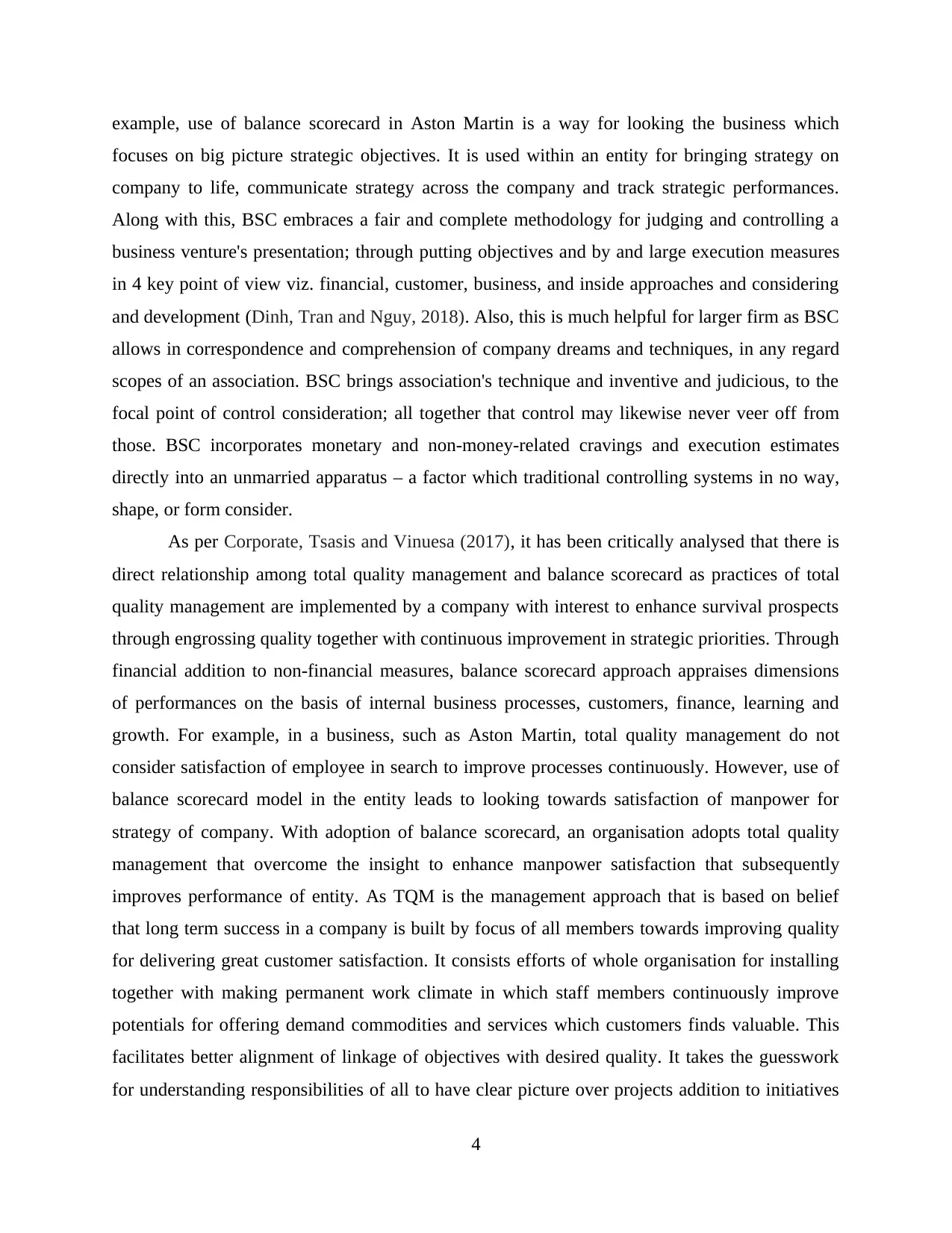
example, use of balance scorecard in Aston Martin is a way for looking the business which
focuses on big picture strategic objectives. It is used within an entity for bringing strategy on
company to life, communicate strategy across the company and track strategic performances.
Along with this, BSC embraces a fair and complete methodology for judging and controlling a
business venture's presentation; through putting objectives and by and large execution measures
in 4 key point of view viz. financial, customer, business, and inside approaches and considering
and development (Dinh, Tran and Nguy, 2018). Also, this is much helpful for larger firm as BSC
allows in correspondence and comprehension of company dreams and techniques, in any regard
scopes of an association. BSC brings association's technique and inventive and judicious, to the
focal point of control consideration; all together that control may likewise never veer off from
those. BSC incorporates monetary and non-money-related cravings and execution estimates
directly into an unmarried apparatus – a factor which traditional controlling systems in no way,
shape, or form consider.
As per Corporate, Tsasis and Vinuesa (2017), it has been critically analysed that there is
direct relationship among total quality management and balance scorecard as practices of total
quality management are implemented by a company with interest to enhance survival prospects
through engrossing quality together with continuous improvement in strategic priorities. Through
financial addition to non-financial measures, balance scorecard approach appraises dimensions
of performances on the basis of internal business processes, customers, finance, learning and
growth. For example, in a business, such as Aston Martin, total quality management do not
consider satisfaction of employee in search to improve processes continuously. However, use of
balance scorecard model in the entity leads to looking towards satisfaction of manpower for
strategy of company. With adoption of balance scorecard, an organisation adopts total quality
management that overcome the insight to enhance manpower satisfaction that subsequently
improves performance of entity. As TQM is the management approach that is based on belief
that long term success in a company is built by focus of all members towards improving quality
for delivering great customer satisfaction. It consists efforts of whole organisation for installing
together with making permanent work climate in which staff members continuously improve
potentials for offering demand commodities and services which customers finds valuable. This
facilitates better alignment of linkage of objectives with desired quality. It takes the guesswork
for understanding responsibilities of all to have clear picture over projects addition to initiatives
4
focuses on big picture strategic objectives. It is used within an entity for bringing strategy on
company to life, communicate strategy across the company and track strategic performances.
Along with this, BSC embraces a fair and complete methodology for judging and controlling a
business venture's presentation; through putting objectives and by and large execution measures
in 4 key point of view viz. financial, customer, business, and inside approaches and considering
and development (Dinh, Tran and Nguy, 2018). Also, this is much helpful for larger firm as BSC
allows in correspondence and comprehension of company dreams and techniques, in any regard
scopes of an association. BSC brings association's technique and inventive and judicious, to the
focal point of control consideration; all together that control may likewise never veer off from
those. BSC incorporates monetary and non-money-related cravings and execution estimates
directly into an unmarried apparatus – a factor which traditional controlling systems in no way,
shape, or form consider.
As per Corporate, Tsasis and Vinuesa (2017), it has been critically analysed that there is
direct relationship among total quality management and balance scorecard as practices of total
quality management are implemented by a company with interest to enhance survival prospects
through engrossing quality together with continuous improvement in strategic priorities. Through
financial addition to non-financial measures, balance scorecard approach appraises dimensions
of performances on the basis of internal business processes, customers, finance, learning and
growth. For example, in a business, such as Aston Martin, total quality management do not
consider satisfaction of employee in search to improve processes continuously. However, use of
balance scorecard model in the entity leads to looking towards satisfaction of manpower for
strategy of company. With adoption of balance scorecard, an organisation adopts total quality
management that overcome the insight to enhance manpower satisfaction that subsequently
improves performance of entity. As TQM is the management approach that is based on belief
that long term success in a company is built by focus of all members towards improving quality
for delivering great customer satisfaction. It consists efforts of whole organisation for installing
together with making permanent work climate in which staff members continuously improve
potentials for offering demand commodities and services which customers finds valuable. This
facilitates better alignment of linkage of objectives with desired quality. It takes the guesswork
for understanding responsibilities of all to have clear picture over projects addition to initiatives
4
⊘ This is a preview!⊘
Do you want full access?
Subscribe today to unlock all pages.

Trusted by 1+ million students worldwide
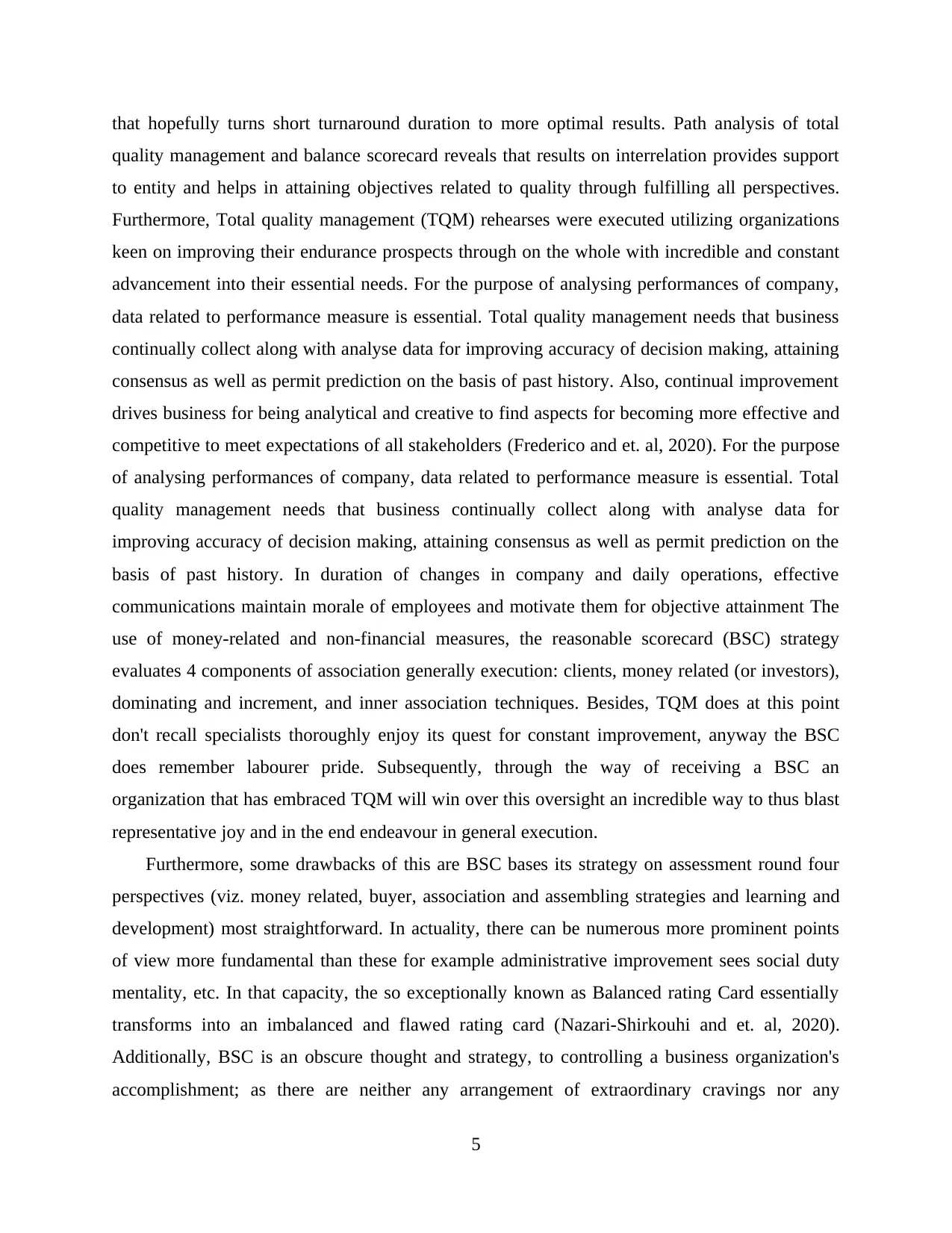
that hopefully turns short turnaround duration to more optimal results. Path analysis of total
quality management and balance scorecard reveals that results on interrelation provides support
to entity and helps in attaining objectives related to quality through fulfilling all perspectives.
Furthermore, Total quality management (TQM) rehearses were executed utilizing organizations
keen on improving their endurance prospects through on the whole with incredible and constant
advancement into their essential needs. For the purpose of analysing performances of company,
data related to performance measure is essential. Total quality management needs that business
continually collect along with analyse data for improving accuracy of decision making, attaining
consensus as well as permit prediction on the basis of past history. Also, continual improvement
drives business for being analytical and creative to find aspects for becoming more effective and
competitive to meet expectations of all stakeholders (Frederico and et. al, 2020). For the purpose
of analysing performances of company, data related to performance measure is essential. Total
quality management needs that business continually collect along with analyse data for
improving accuracy of decision making, attaining consensus as well as permit prediction on the
basis of past history. In duration of changes in company and daily operations, effective
communications maintain morale of employees and motivate them for objective attainment The
use of money-related and non-financial measures, the reasonable scorecard (BSC) strategy
evaluates 4 components of association generally execution: clients, money related (or investors),
dominating and increment, and inner association techniques. Besides, TQM does at this point
don't recall specialists thoroughly enjoy its quest for constant improvement, anyway the BSC
does remember labourer pride. Subsequently, through the way of receiving a BSC an
organization that has embraced TQM will win over this oversight an incredible way to thus blast
representative joy and in the end endeavour in general execution.
Furthermore, some drawbacks of this are BSC bases its strategy on assessment round four
perspectives (viz. money related, buyer, association and assembling strategies and learning and
development) most straightforward. In actuality, there can be numerous more prominent points
of view more fundamental than these for example administrative improvement sees social duty
mentality, etc. In that capacity, the so exceptionally known as Balanced rating Card essentially
transforms into an imbalanced and flawed rating card (Nazari-Shirkouhi and et. al, 2020).
Additionally, BSC is an obscure thought and strategy, to controlling a business organization's
accomplishment; as there are neither any arrangement of extraordinary cravings nor any
5
quality management and balance scorecard reveals that results on interrelation provides support
to entity and helps in attaining objectives related to quality through fulfilling all perspectives.
Furthermore, Total quality management (TQM) rehearses were executed utilizing organizations
keen on improving their endurance prospects through on the whole with incredible and constant
advancement into their essential needs. For the purpose of analysing performances of company,
data related to performance measure is essential. Total quality management needs that business
continually collect along with analyse data for improving accuracy of decision making, attaining
consensus as well as permit prediction on the basis of past history. Also, continual improvement
drives business for being analytical and creative to find aspects for becoming more effective and
competitive to meet expectations of all stakeholders (Frederico and et. al, 2020). For the purpose
of analysing performances of company, data related to performance measure is essential. Total
quality management needs that business continually collect along with analyse data for
improving accuracy of decision making, attaining consensus as well as permit prediction on the
basis of past history. In duration of changes in company and daily operations, effective
communications maintain morale of employees and motivate them for objective attainment The
use of money-related and non-financial measures, the reasonable scorecard (BSC) strategy
evaluates 4 components of association generally execution: clients, money related (or investors),
dominating and increment, and inner association techniques. Besides, TQM does at this point
don't recall specialists thoroughly enjoy its quest for constant improvement, anyway the BSC
does remember labourer pride. Subsequently, through the way of receiving a BSC an
organization that has embraced TQM will win over this oversight an incredible way to thus blast
representative joy and in the end endeavour in general execution.
Furthermore, some drawbacks of this are BSC bases its strategy on assessment round four
perspectives (viz. money related, buyer, association and assembling strategies and learning and
development) most straightforward. In actuality, there can be numerous more prominent points
of view more fundamental than these for example administrative improvement sees social duty
mentality, etc. In that capacity, the so exceptionally known as Balanced rating Card essentially
transforms into an imbalanced and flawed rating card (Nazari-Shirkouhi and et. al, 2020).
Additionally, BSC is an obscure thought and strategy, to controlling a business organization's
accomplishment; as there are neither any arrangement of extraordinary cravings nor any
5
Paraphrase This Document
Need a fresh take? Get an instant paraphrase of this document with our AI Paraphraser
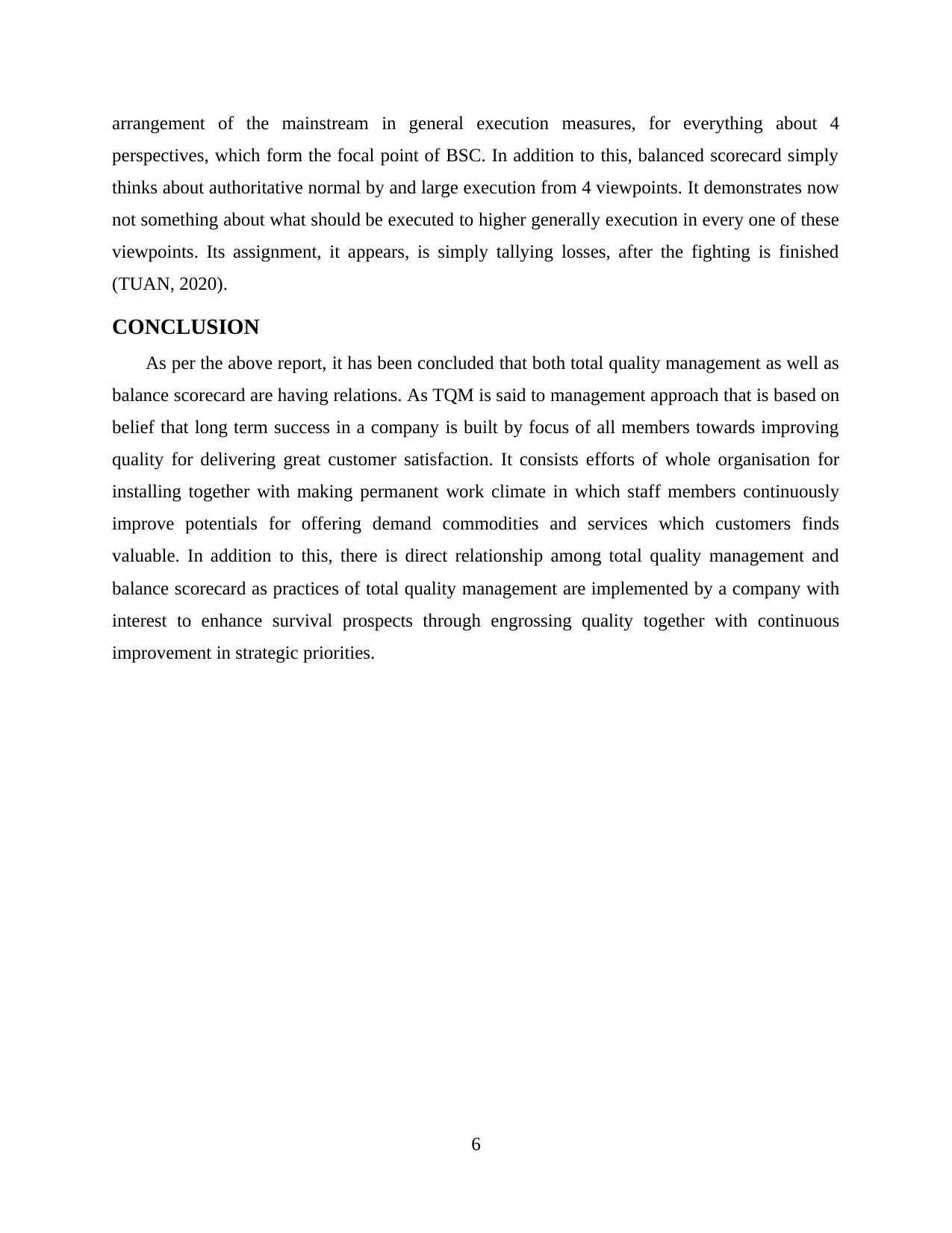
arrangement of the mainstream in general execution measures, for everything about 4
perspectives, which form the focal point of BSC. In addition to this, balanced scorecard simply
thinks about authoritative normal by and large execution from 4 viewpoints. It demonstrates now
not something about what should be executed to higher generally execution in every one of these
viewpoints. Its assignment, it appears, is simply tallying losses, after the fighting is finished
(TUAN, 2020).
CONCLUSION
As per the above report, it has been concluded that both total quality management as well as
balance scorecard are having relations. As TQM is said to management approach that is based on
belief that long term success in a company is built by focus of all members towards improving
quality for delivering great customer satisfaction. It consists efforts of whole organisation for
installing together with making permanent work climate in which staff members continuously
improve potentials for offering demand commodities and services which customers finds
valuable. In addition to this, there is direct relationship among total quality management and
balance scorecard as practices of total quality management are implemented by a company with
interest to enhance survival prospects through engrossing quality together with continuous
improvement in strategic priorities.
6
perspectives, which form the focal point of BSC. In addition to this, balanced scorecard simply
thinks about authoritative normal by and large execution from 4 viewpoints. It demonstrates now
not something about what should be executed to higher generally execution in every one of these
viewpoints. Its assignment, it appears, is simply tallying losses, after the fighting is finished
(TUAN, 2020).
CONCLUSION
As per the above report, it has been concluded that both total quality management as well as
balance scorecard are having relations. As TQM is said to management approach that is based on
belief that long term success in a company is built by focus of all members towards improving
quality for delivering great customer satisfaction. It consists efforts of whole organisation for
installing together with making permanent work climate in which staff members continuously
improve potentials for offering demand commodities and services which customers finds
valuable. In addition to this, there is direct relationship among total quality management and
balance scorecard as practices of total quality management are implemented by a company with
interest to enhance survival prospects through engrossing quality together with continuous
improvement in strategic priorities.
6
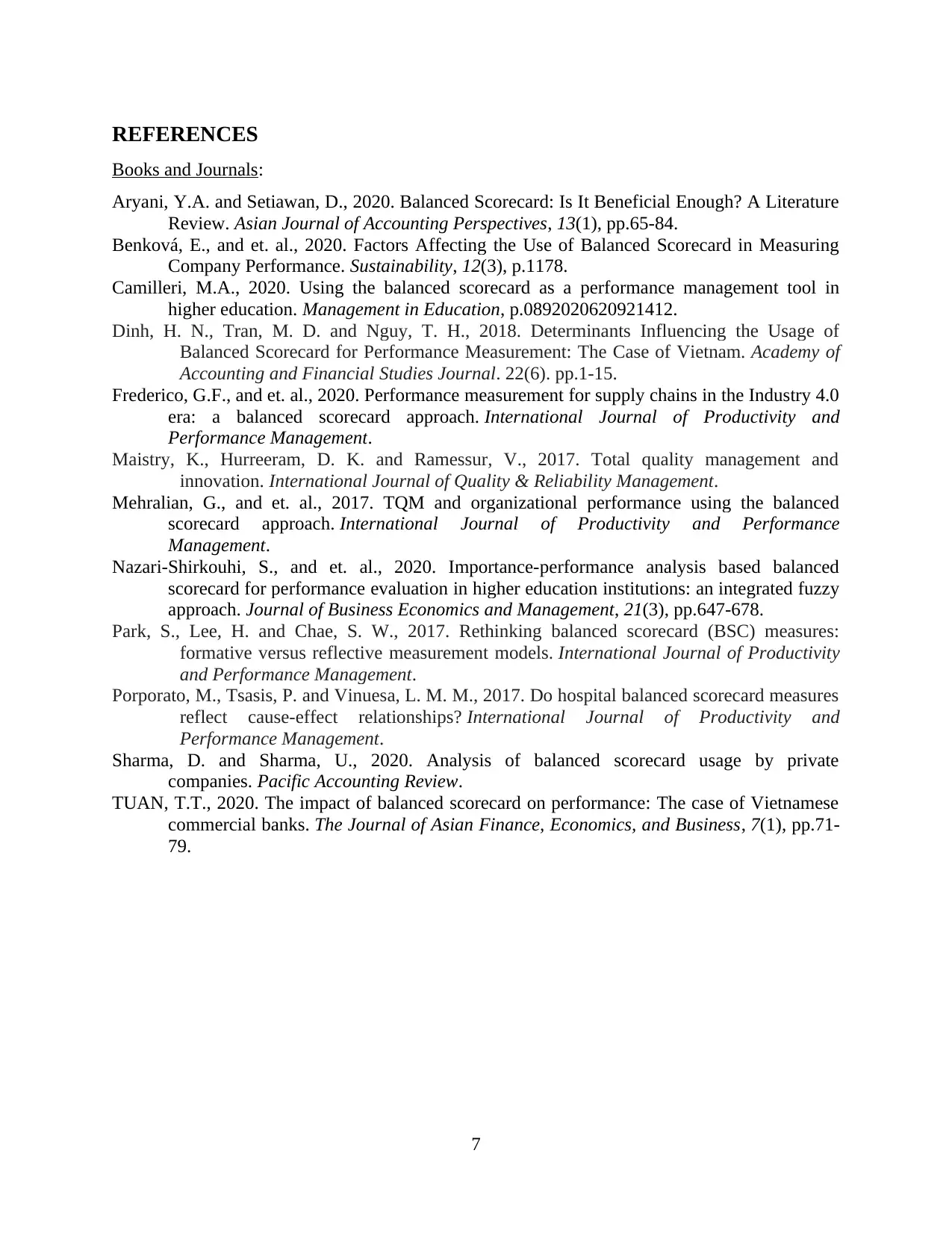
REFERENCES
Books and Journals:
Aryani, Y.A. and Setiawan, D., 2020. Balanced Scorecard: Is It Beneficial Enough? A Literature
Review. Asian Journal of Accounting Perspectives, 13(1), pp.65-84.
Benková, E., and et. al., 2020. Factors Affecting the Use of Balanced Scorecard in Measuring
Company Performance. Sustainability, 12(3), p.1178.
Camilleri, M.A., 2020. Using the balanced scorecard as a performance management tool in
higher education. Management in Education, p.0892020620921412.
Dinh, H. N., Tran, M. D. and Nguy, T. H., 2018. Determinants Influencing the Usage of
Balanced Scorecard for Performance Measurement: The Case of Vietnam. Academy of
Accounting and Financial Studies Journal. 22(6). pp.1-15.
Frederico, G.F., and et. al., 2020. Performance measurement for supply chains in the Industry 4.0
era: a balanced scorecard approach. International Journal of Productivity and
Performance Management.
Maistry, K., Hurreeram, D. K. and Ramessur, V., 2017. Total quality management and
innovation. International Journal of Quality & Reliability Management.
Mehralian, G., and et. al., 2017. TQM and organizational performance using the balanced
scorecard approach. International Journal of Productivity and Performance
Management.
Nazari-Shirkouhi, S., and et. al., 2020. Importance-performance analysis based balanced
scorecard for performance evaluation in higher education institutions: an integrated fuzzy
approach. Journal of Business Economics and Management, 21(3), pp.647-678.
Park, S., Lee, H. and Chae, S. W., 2017. Rethinking balanced scorecard (BSC) measures:
formative versus reflective measurement models. International Journal of Productivity
and Performance Management.
Porporato, M., Tsasis, P. and Vinuesa, L. M. M., 2017. Do hospital balanced scorecard measures
reflect cause-effect relationships? International Journal of Productivity and
Performance Management.
Sharma, D. and Sharma, U., 2020. Analysis of balanced scorecard usage by private
companies. Pacific Accounting Review.
TUAN, T.T., 2020. The impact of balanced scorecard on performance: The case of Vietnamese
commercial banks. The Journal of Asian Finance, Economics, and Business, 7(1), pp.71-
79.
7
Books and Journals:
Aryani, Y.A. and Setiawan, D., 2020. Balanced Scorecard: Is It Beneficial Enough? A Literature
Review. Asian Journal of Accounting Perspectives, 13(1), pp.65-84.
Benková, E., and et. al., 2020. Factors Affecting the Use of Balanced Scorecard in Measuring
Company Performance. Sustainability, 12(3), p.1178.
Camilleri, M.A., 2020. Using the balanced scorecard as a performance management tool in
higher education. Management in Education, p.0892020620921412.
Dinh, H. N., Tran, M. D. and Nguy, T. H., 2018. Determinants Influencing the Usage of
Balanced Scorecard for Performance Measurement: The Case of Vietnam. Academy of
Accounting and Financial Studies Journal. 22(6). pp.1-15.
Frederico, G.F., and et. al., 2020. Performance measurement for supply chains in the Industry 4.0
era: a balanced scorecard approach. International Journal of Productivity and
Performance Management.
Maistry, K., Hurreeram, D. K. and Ramessur, V., 2017. Total quality management and
innovation. International Journal of Quality & Reliability Management.
Mehralian, G., and et. al., 2017. TQM and organizational performance using the balanced
scorecard approach. International Journal of Productivity and Performance
Management.
Nazari-Shirkouhi, S., and et. al., 2020. Importance-performance analysis based balanced
scorecard for performance evaluation in higher education institutions: an integrated fuzzy
approach. Journal of Business Economics and Management, 21(3), pp.647-678.
Park, S., Lee, H. and Chae, S. W., 2017. Rethinking balanced scorecard (BSC) measures:
formative versus reflective measurement models. International Journal of Productivity
and Performance Management.
Porporato, M., Tsasis, P. and Vinuesa, L. M. M., 2017. Do hospital balanced scorecard measures
reflect cause-effect relationships? International Journal of Productivity and
Performance Management.
Sharma, D. and Sharma, U., 2020. Analysis of balanced scorecard usage by private
companies. Pacific Accounting Review.
TUAN, T.T., 2020. The impact of balanced scorecard on performance: The case of Vietnamese
commercial banks. The Journal of Asian Finance, Economics, and Business, 7(1), pp.71-
79.
7
⊘ This is a preview!⊘
Do you want full access?
Subscribe today to unlock all pages.

Trusted by 1+ million students worldwide
1 out of 9
Related Documents
Your All-in-One AI-Powered Toolkit for Academic Success.
+13062052269
info@desklib.com
Available 24*7 on WhatsApp / Email
![[object Object]](/_next/static/media/star-bottom.7253800d.svg)
Unlock your academic potential
Copyright © 2020–2025 A2Z Services. All Rights Reserved. Developed and managed by ZUCOL.




